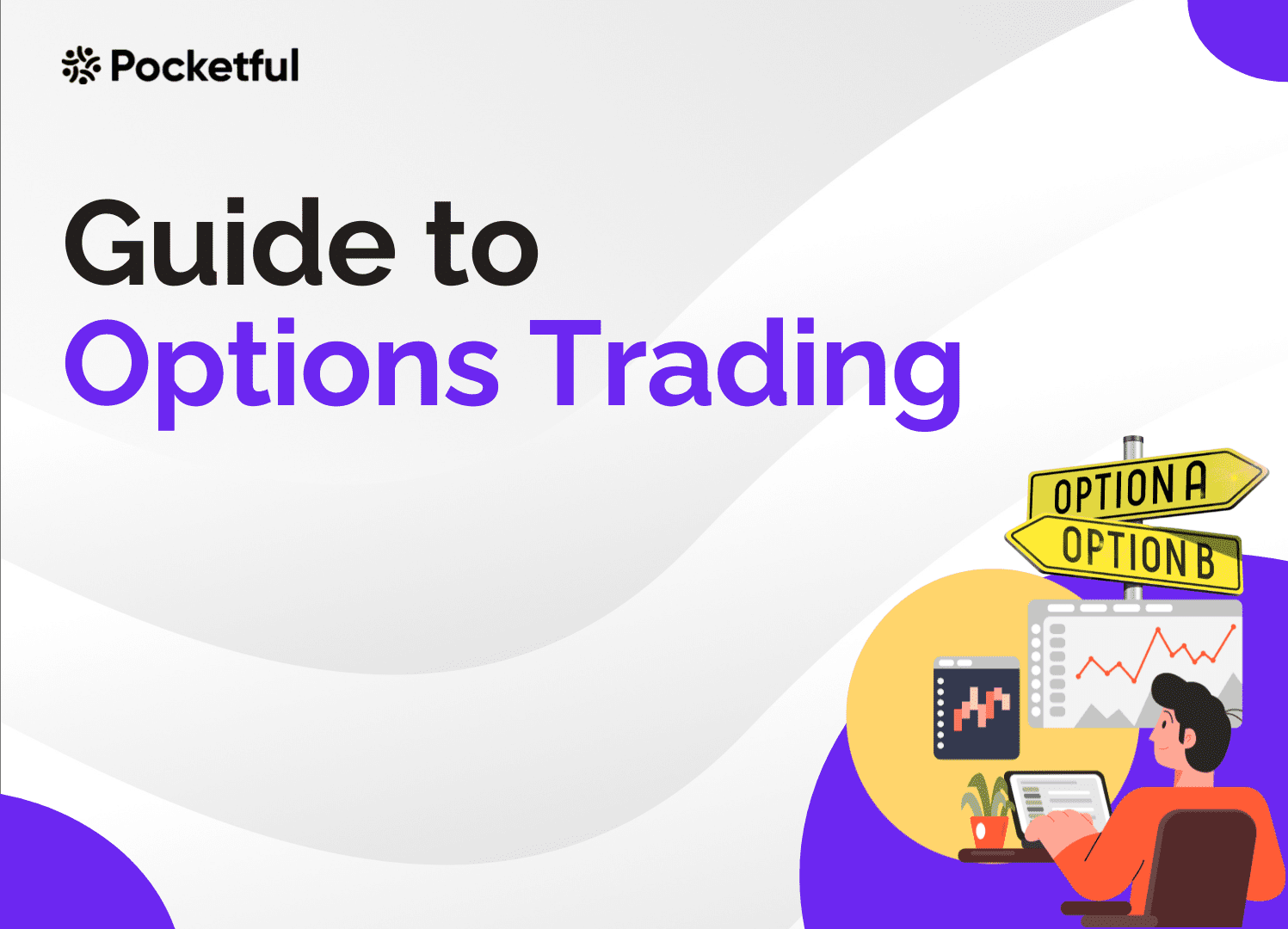| Type | Description | Contributor | Date |
|---|---|---|---|
| Post created | Pocketful Team | Jun-26-24 | |
| Add new links | Nisha | Mar-18-25 |
What is Options Trading?

Have you ever wondered how traders make a living out of stock markets? Investments are for the long term, but options trading has the potential to provide extraordinary returns in a short amount of time. Sounds interesting? Let’s see how we can make the best use of it.
Understanding Options Trading
Options trading is the process of buying and selling specific assets at a predetermined date and price. It requires an understanding of the options and various strategies. Options trading is tougher than stock or index trading as it requires knowledge of various factors like strike price, premium, expiry, option type, volatility, etc.
Options are mainly used as hedging instruments, as they protect against the downside. Along with that, it can also be used to generate income when the market conditions are not suitable for investing.
Options are derivative contracts and are classified into two types: Call and Put. A call or put option is a type of option contract that gives the buyer the right to buy or sell an asset at a predetermined price on a specific date but not the obligation to do so.
It is crucial for beginners to understand options trading in detail before investing real money. Let’s try to understand the basic concepts.
Read Also: Option Chain Analysis: A Detail Guide for Beginners
How to Trade Options?

1. Evaluate Financial Goals along with Risk & Return Profile
Starting trading in options is not as easy as it seems, as it requires a good understanding of options and how to use them in your favor, as options trading is more complex than trading in stocks. Also, in some cases, options trading may require significant amounts of capital (e.g. shorting the options).
First, one needs to assess financial goals and select suitable asset classes and instruments to use in the financial market. Then, if suitable, one should decide to trade options. We can follow the process listed below to assess whether options are suitable for investors.
- Investment objectives: This usually includes growth/income, capital preservation or speculation.
- Trading experience: This is important for your risk assessment.
- Financial position: How much liquid cash or investments an investor has, his annual income, expenditures, savings pattern and properties, etc.
- Option type: Calls, puts or strategies and spreads. And whether they are covered or naked. The seller or option writer is obligated to deliver the underlying stock if the option is exercised.
2. Understand the Type of Options
There are two styles of options, American and European; the difference between these two is the timing of exercising the option. Holders of an American option can exercise at any point up to the expiry date, whereas holders of European options can only exercise on the day of expiry. As American options offer more flexibility for the option buyer (and more risk for the option seller), they usually cost more than European options. Expiration dates can range from days to months. For long-term investors, monthly expiration is preferable. Longer expirations give the stock more time to move and time for your investment ideas to play out. As such, the longer the expiration period, the more expensive the option. A longer expiration is also useful because the option can retain time value.
3. Pick The Options To Buy Or Sell
A call option is a contract that gives the right, but not the obligation, to buy an asset at a predetermined price on a specific date. A put option gives the right, but not the obligation, to sell an asset at a stated price on a particular date.
Now, it depends upon your view and expectation on which direction you think the market or asset will move, and as per that, you will decide on the type of option and whether you will buy it or sell it. A few views are given for your reference.
If the view is that the asset price will move up: Buy a call option or sell a put option.
If the view is that the asset price will go down: Buy a put option or sell a call option.
If the view is that the asset price will stay in a range: Sell a call option or sell a put option.
4. Understanding and choosing the right option strike price
There are so many strike prices available that are quoted in the option chain; the increment between strike prices is standardized and based on the underlying. We can’t just choose any strike price. The choice of strike is so crucial that it can be the difference between profit and loss.
While buying, the trader should buy an option that the trader thinks will be in the money (ITM) at expiry in an amount greater than the premium paid. Call options are ITM when the strike price is lower than the market price of the underlying security. For example- If your view is that a specific company’s share price of Rs. 500 will increase to Rs. 550 by expiry, it is advisable to purchase a call option. Ensure that the call option you purchase has a strike price of less than Rs. 550. If the stock rises above the strike price, your option is likely to be in the money. In the same way, if you suspect that the share price of the company is falling to Rs. 450, it is best to purchase a put option with a strike price above this. In case of a stock price drop, your option is likely to be in the money.
5. Understanding the Option Premium
The price we pay for an option is called the option premium; it has two components: intrinsic value and time value. Intrinsic value is the difference between the strike price and the asset price. Time value is whatever is left; it factors in how volatile the asset is and compensates for the time left till expiry.
For call options, intrinsic value is calculated as
Intrinsic Value = Spot Price – Strike Price
For put options, intrinsic value is calculated as
Intrinsic Value = Strike Price – Spot Price
It is calculated as the difference between premium and intrinsic value.
Time Value = Premium-Intrinsic Value
The time value of the option premium is dependent on factors like the volatility of the underlying, the time to expiration, interest rate, dividend payments, etc.
For example, suppose you buy a call option with a strike price of 200 while the stock costs Rs 210. Let’s assume the option’s premium is Rs 15. The intrinsic value is Rs 10 (210 – 200), and the time value is Rs 5.
6. Understanding the Option Greeks
Option Greeks are the key factors that can influence option prices. They are the measure of the sensitivity of an option to changes in the price of the underlying stock, market volatility, and time to expiration. In the trading market, an underlying asset’s spot price, volatility, and time to expiration change simultaneously. Options Greeks help traders understand the impact of changes in these factors on their position.
There are five option Greeks:
- Delta: It measures the change in premium due to a change in the price of the underlying.
- Gamma: it is the rate of change in Delta.
- Vega: Change in the price of options due to change in volatility.
- Theta: It measures the impact of time loss on the price of the option.
- Rho: It measures changes in the option price due to changes in interest or risk-free rates.
7. Analyze The Time Frame Of The Option
There is an expiry date for every option contract. The expiry dates of Options may vary from weeks, months to even years. The timeframe of the option contract should be according to the timeframe considered in the trading strategy. The timeframe the trader thinks is required to witness the expected move must be consistent with the option expiry date.
Read Also: What Is an Option Contract?
Conclusion
Options trading is available to all market participants. For beginners, options trading can be a little bit difficult at first, but after understanding the concepts and practicing, they can trade in options with real money. One should have some knowledge of market direction; this can be done by leveraging the power of an option chain. This will evaluate the expiration date, strike price, volume, addition or unwinding, etc. Accordingly, one may decide to choose options to trade depending upon the view and direction. Options trading is not as easy as stock trading as it is a sophisticated derivative tool.
As a beginner, one should learn about options basics and different strategies like Protective Put, Covered Call, Straddle, Strangle, and different types of Spreads. There are various pros of options trading, such as high return potential, cost-effectiveness, availability of many strategies, etc., and cons are all the stocks or assets don’t have options available, or they may be less liquid, high commissions are involved also some strategies are sensitive to time decay etc. Traders should pay attention to these to make balanced decisions.
Frequently Asked Questions (FAQ’s)
Can anyone trade options?
As it is a derivative instrument, some understanding is required, so beginners should learn the basics before entering an option trade to understand how it works.
How are Stock Options settled?
Stock Options are settled either in cash settlement where the counterparties exchange cash flows or through physical delivery of assets, in the case of ITM derivative positions.
How are Index Options settled?
Index Options are settled in cash one day after the execution, i.e. (T+1).
Does Options trading require a margin?
An option only requires you to pay the premium, but no additional margin is required. However, selling options require a margin to cover potential losses. This is true for both calls and puts. Some option strategies, such as covered calls and covered puts, have no margin requirement because the underlying stock is used as collateral.
What’s the contract cycle for options in India?
Options for equity in India have a monthly contract, while index options have weekly contracts.
Disclaimer
The securities, funds, and strategies discussed in this blog are provided for informational purposes only. They do not represent endorsements or recommendations. Investors should conduct their own research and seek professional advice before making any investment decisions.